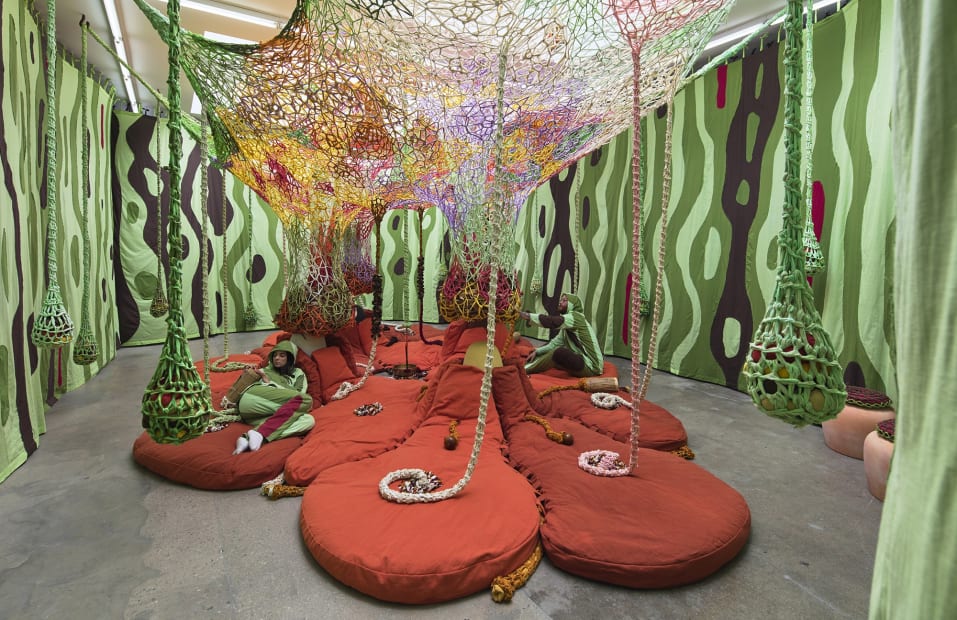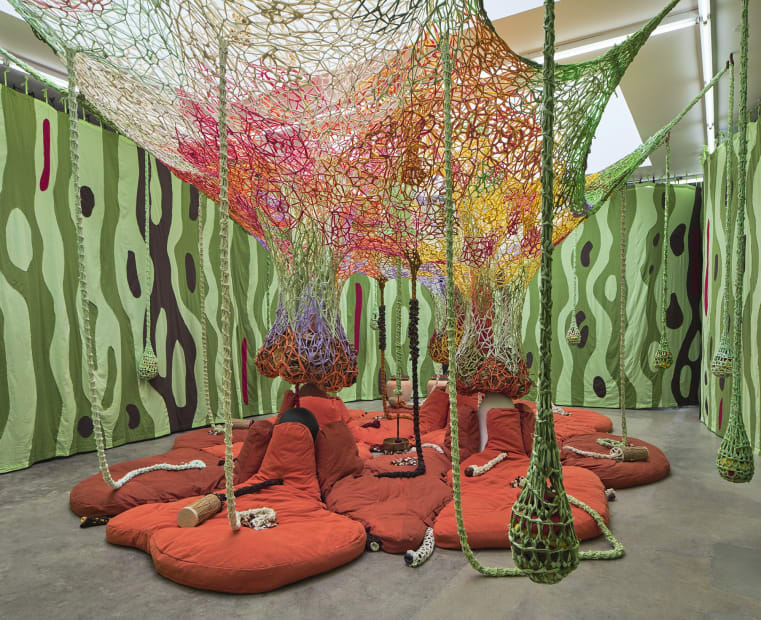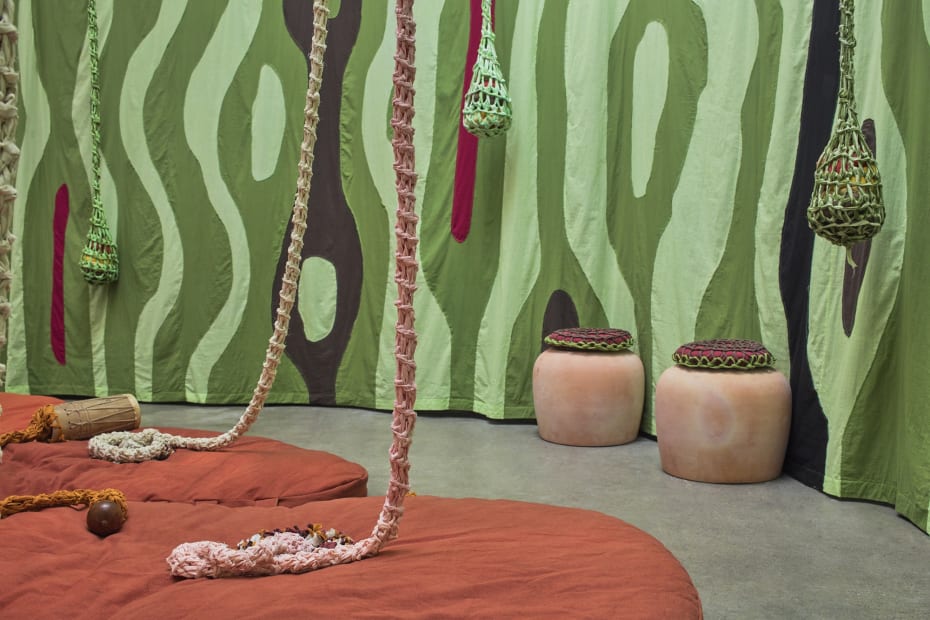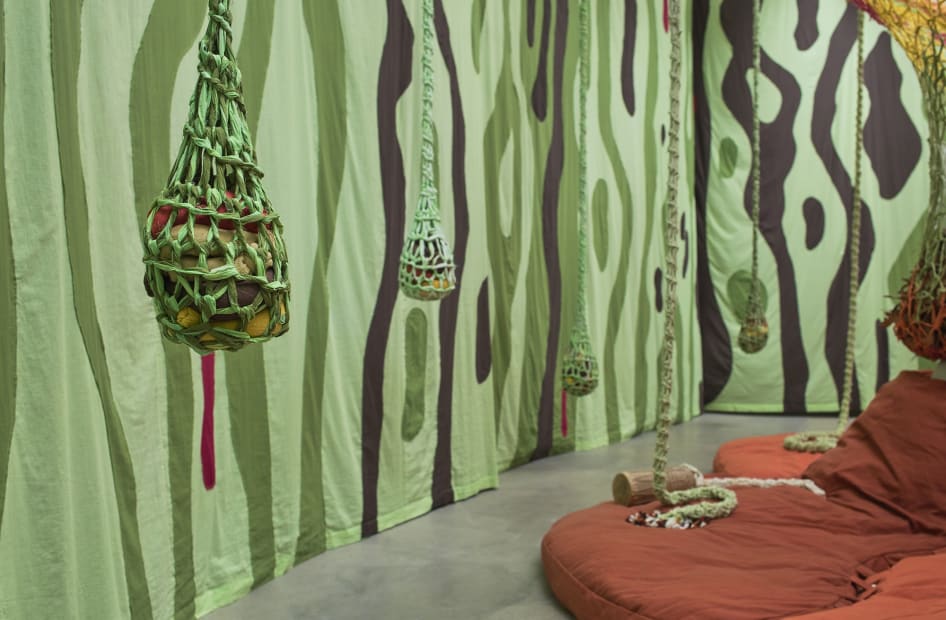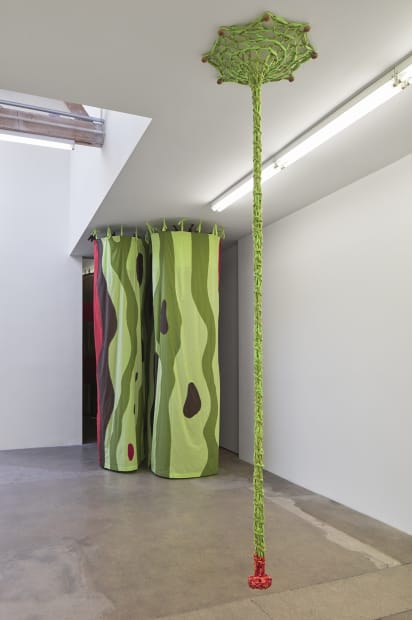ERNESTO NETO: CHILDREN OF THE EARTH: Tanya Bonakdar Gallery, Los Angeles
Tanya Bonakdar Gallery is pleased to announce Children of the Earth, a solo exhibition with Brazilian artist Ernesto Neto, at our Los Angeles Gallery location, on view September 14 - November 2, 2019. This will be the artist's first exhibition in Los Angeles since his one-person presentation at the Museum of Contemporary Art, Pacific Design Center in 2003.
One of the most influential artists of his generation, Neto has become known for his immersive environments of color, fragrance and sound, and for his use of materials such as hand-dyed fabric, spices and shells. Since the 1990s Ernesto Neto has created a distinct body of work— an ongoing formal inquiry into space, volume, balance and gravity that is equally informed by sensuality, energy and spirituality. Inspired by a wide range of sources—from Brazilian avant-garde artists such as Hélio Oiticica and Lygia Clark, through the Modernist abstraction of Calder and Brancusi, to the natural world, shamanism and craft culture—Neto’s art-making practice has pushed the boundaries of sculpture and radically redefined the relationship between artwork and viewer.
In Children of the Earth, Neto creates an alluring environment of color, materials, fragrances and sound, transforming the gallery into a living organism, where visitors are encouraged to wander, touch, feel, interact and connect.
Upon entering the gallery, a curtain in green and brown patterns invites the viewer to walk through a tunnel-like path which leads to the main gallery space. Entitled Children of the Earth, a large-scale installation of crochet, spices and leaves hangs from the ceiling to the floor. The large biomorphic shape—hand knitted in vibrant colors of yellows, greens, purples and reds—is flanged by drop-shaped crochet vines that serve as counterbalance and establish the delicate equilibrium of the piece. Here, references to nature interconnect with formal questions of tension, gravity and weight. On the floor, tracing the outline of the structure above, a soft surface of handmade textile is installed. Ceramic vases sprout from the ground, representing the diversity of peoples inhabiting the planet, and that ultimately, we are all the children of the earth. Musical instruments, spices, and crystals comprise an integral part of this malleable, highly tactile sculpture, which engages the five senses, and invites viewers to connect with one another in new and meaningful ways. In expanding the boundaries of physical space and calling for a new type of interaction, Neto creates an experience that is physical, sensorial, intellectual and social all at once.
Surrounding the piece, as another layer of skin, hand-sewn fabric hangs. The organic pattern and color pallet further recall the natural world, as they invoke the forest, wood grain, or the circulatory system of a plant. The path the visitor follows throughout the space, and from within the piece—like an organic line in nature—is analogues to Neto’s conception of life where there is “no separation between humans and nature, nor between art making and art experience”, highlighting that in the exhibition, as in life, everything is connected.
In the back gallery a hanging platform with a crochet canopy and crochet tendrils is installed. Designed for direct interaction, this is a healing bed that offers a moment of rest and respite, where people can connect to themselves, as to one another. The tendrils function as ‘connectors’, as they amplify the pulse of life while connecting us to the environment and to our own physicality. Embracing the participant in its serenity, the healing bed investigates the meeting point of art, sensation, personal connection and the human body.
The exhibition as a whole connects mind, body and nature through a sensory experience that is unmediated. It is an invitation to connect to ourselves and to our planet at a time when connectivity is most needed. For Neto, sculpture is an extension of the body, and the body is ultimately an extension of earth.
Born in 1964 in Rio de Janeiro, the artist continues to live and work in Brazil. His work has been the subject of major museum exhibitions worldwide. Recent highlights include Ernesto Neto: Sopro (Blow) a large-scale survey of the artist’s work at the São Paulo Pinacoteca, Brazil which will travel to the Museum of Latin American Art in Buenos Aires, Argentina and to the Palacio de La Moneda Cultural Center, Santiago, Chile; GaiaMotherTree, a site specific installation at the Zurich Train Station in collaboration with the Foundation Beyeler (2018); Water Falls from my Breast to the Sky, a site-specific permanent installation at the Museum of Contemporary Art Chicago (2017); Ernesto Neto, Museum of Contemporary Art Kiasma, Helsinki, Finland (2016); Ernesto Neto and the Huni Kuin ~ Aru Kuxipa | Sacred Secret, TBA 21 Contemporary, Augarten, Vienna, Austria (2015); Ernesto Neto: Haux Haux, Arp Museum Bahnhof Rolandseck, Reman, Germany (2014); and Ernesto Neto: The body that carries me, at the Guggenheim, Bilbao, Spain (2014).
The artist also presented important solo exhibitions at the Nasher Sculpture Center, Dallas (2012); Faena Arts Center, Buenos Aires, which traveled to Estação Leopoldina, Rio de Janeiro (2011-2012); Museo de Arte Contemporáneo de Monterrey, Mexico (2011); Hayward Gallery, Southbank Centre, London (2010); Museum of Modern Art, New York (2010); Astrup Fearnley Museum of Modern Art, Oslo (2010); Sao Paulo Museum of Modern Art (2010); Museo d'Arte Contemporanea Roma, Italy (2008); Museum of Contemporary Art, San Diego (2007); Museum of Contemporary Art, Sydney, Australia (2002); and the Hirshhorn Museum and Sculpture Garden, Washington, D.C. (2002), among others. In 2001 he represented Brazil at the 49th Venice Biennale, and in 2017 was prominently featured in Vive Arte Viva at the 57th Venice Biennale curated by Christine Macel. His work has also been featured in numerous group exhibitions and biennials, most recently the 14th Biennale de Lyon, curated by Emma Lavigne (2017), Manifesta 7 (2015), along with group shows at Guggenheim Bilbao, Albright Knox Art Gallery, and Centre Pompidou-Metz.
Neto’s work is well represented in international museum collections, including those of the Museum of Modern Art, New York; Tate Gallery, London; Solomon R. Guggenheim Museum, New York; Museum of Contemporary Art, Los Angeles; Museum of Modern Art, San Francisco; Museum of Contemporary Art, San Diego; Carnegie Museum of Art, Pittsburgh; Museum Boijmans van Beuningen, Rotterdam; Centre Pompidou, Paris; Hara Museum, Tokyo; Contemporary Art Center of Inhotim, Brazil; Hirshhorn Museum and Sculpture Garden, Washington, D.C.; Milwaukee Art Museum, among many others.
All installation images above: Photo by Flying Studio
